AgustaWestland AW159 Wildcat
| AW159 Wildcat | |
|---|---|
 | |
| Wildcat HMA2 naval variant in 2013 | |
| Role | Utility, SAR and ASuW helicopter |
| National origin | United Kingdom |
| Manufacturer | Leonardo-Finmeccanica (since 2016) AgustaWestland |
| First flight | 12 November 2009[1] |
| Introduction | 29 August 2014 (AH1)[2] |
| Primary users | British Army Royal Navy |
| Produced | 2009-present |
| Developed from | Westland Super Lynx |
The AgustaWestland AW159 Wildcat (previously called the Future Lynx and Lynx Wildcat) is an improved version of the Westland Super Lynx military helicopter designed to serve in the battlefield utility, search and rescue and anti-surface warfare roles. In British service, common variants are being operated by both the Royal Navy and British Army to replace their ageing Lynx Mk.7/8/9 rotorcraft. The AW159 has also been offered to several export customers, and been ordered by the Republic of Korea Navy and the Philippine Navy.
Development
In 1995, the British Government announced that the Royal Navy's existing Westland Lynx helicopters were to be replaced, at that point, the service was intended to operate an all-Merlin fleet.[3] Despite this stated intent, Westland Helicopters continued to hold talks with the Ministry of Defence (MOD) to find a future role for the type during the late 1990s; the firm issued multiple proposals to either extend the life of the existing Super Lynx via upgrade programs or more ambitious remanufacturing programs incorporating varying degrees of new components.[4] In 2002, the Future Lynx project originated in two studies to determine the suitability of a derivative of the Super Lynx 300 to replace the existing Lynx helicopters of the Royal Navy and British Army. These requirements were known as the Surface Combatant Maritime Rotorcraft (SCMR) and Battlefield Light Utility Helicopter (BLUH) programmes, respectively.[5]
In July 2002, AgustaWestland received a contract to conduct a formal assessment phase of the Future Lynx.[6] On 22 July 2002, a collaboration agreement was signed between AgustaWestland and Thales Group, under which Thales was assigned development responsibility for the program's core avionics, including communications, navigation, and flight management electronics;[7] that same day, additional MOD funding for the fledgling Future Lynx program was announced as having been allocated.[8] By April 2003, the in-service dates for the BLUH and SCMR programmes were reported as being April 2007 and April 2008 respectively.[6] Early on, AgustaWestland elected to adopt a glass cockpit incorporating electronics upgrades from the AgustaWestland AW101 along with various airframe improvements, such as a redesigned tail rotor and nose, as well as an increased use of machined components over fabricated counterparts, for the Future Lynx.[6][9] By July 2004, the option of upgrading and remanufacturing the first generation Lynx had reportedly been judged to be uneconomical, and the BLUH program of building a new generation airframe had been given prominence instead.[10]
In late 2004, the National Audit Office (NOA) criticised the UK's existing helicopter fleet as being insufficient; concurrently, a major reorganization of the MOD's procurement process subjected ongoing helicopter programs to major restructuring.[11] The BLUH was reportedly deemed unaffordable, and it was speculated that a more modest sensor fit could be used, as well as the procurement of alternative platforms such as the NHIndustries NH90, Eurocopter EC120, or Eurocopter EC635 instead of the Future Lynx.[11][12] Ultimately, the utility transport aspect of the BLUH requirement was de-emphasised and the programme renamed Battlefield Reconnaissance Helicopter (BRH).[13]
In early 2005, the MOD was reportedly deliberating on whether to launch an open competition for other companies to bid to meet the BRH requirement, or to sole-source the contract from AgustaWestland to proceed with the Future Lynx.[14] In late March 2005, the MOD confirmed the Future Lynx as being its preferred option for its rotorcraft renewal program, and was expected to place a non-competitive contract with AgustaWestland later that year.[15][16] The signing of the contract was delayed to the following year, this was reportedly in part due to preparation and release of the 2005 Defence Industrial Strategy, which supported the selection of the Future Lynx.[9]

On 22 June 2006, the MOD awarded AgustaWestland a £1 billion contract for 70 Future Lynx helicopters as a commitment under the Strategic Partnering Arrangement with AgustaWestland. The programme envisaged providing the British Army with 40 aircraft and Royal Navy with 30, with an option for a further 10, split equally between Army and Navy.[17][18] By late 2007, the Future Lynx was scheduled to enter service with the British Army and Royal Navy in 2014 and 2015 respectively.[19] In 2008, the cancellation of the Future Lynx program has reportedly been under consideration.[20] In December 2008, the MoD announced that the main contract would be proceeding, only incurring a minor cut in numbers set to be procured, for a total of 62 rotorcraft.[21]
In October 2007, following the passing of an interim critical design review, the Future Lynx program proceeded to the manufacturing phase; the first metal was cut on the initial flight-test rotorcraft that same month.[19] In September 2008, the powerplant selected for the Future Lynx, the LHTEC CTS800-4N, received European Aviation Safety Agency (EASA) type certification, enabling production deliveries to commence.[22] In November 2008, GKN delivered the first complete airframe to AgustaWestland; the new airframe reportedly had an 80 per cent lower part count than the earlier generation Lynx, which was achieved via the use of monolithic machine components.[23]
On 24 April 2009, it was announced that the Future Lynx had been designated AW159 by AgustaWestland,[24][20] and would be known in British military service as the Wildcat.[25] On 12 November 2009, the first Lynx Wildcat conducted the type's maiden flight from AgustaWestland's facility in Yeovil, Somerset.[1] On 14 October 2010, the second AW159 performed its first flight;[26] on 19 November 2010, a third Wildcat joined the flight test program.[27] In July 2009, it was announced that the cost of the programme had increased to £1.7 billion.[28] In December 2011, it was reported that four additional Wildcats had been ordered for use by British special forces. These are to be joined by four from the current fleet on order, for a total of eight aircraft to operate as Wildcat Light Assault Helicopters.[29]
Design
.jpg)
The AW159 Wildcat is the successor to, and a further development of, the Westland Lynx.[30] While the AW159 shares broad similarities in appearance to the Lynx, it has significant design differences and is heavily modernised and adapted to gain new attributes and functionality.[30] The AW159 comprises 95% new components; the remaining 5%, consisting of such items as the fuel system and main rotor gearbox, are interchangeable with the Lynx AH7 and HMA8 variants.[31] During development, the Army and Navy variants of the Wildcat reportedly maintained 98 per cent commonality with one another.[20] The AW159 is the first helicopter by AgustaWestland to be designed inside an entirely digital environment.[30] Among other changes, certain external elements of the Wildcat, such as the tail rotor, have been redesigned for greater durability and stealth qualities.[30]
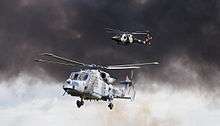
Both Army and Navy variants have a common airframe, which is manufactured by GKN Aerostructures;[20] the airframe has been marinised for operations in the naval environment and provides for a greater airframe lifespan of 12,000 flight hours.[19] The wheeled undercarriage is also strengthened for naval landings on both variants. The AW159 is powered by two 1,362 hp (1,016 kW) LHTEC CTS800 turboshaft engines which drives the rotorcraft's BERP IV rotor blades via a new transmission, increasing the maximum take-off weight by more than 1 ton over the legacy Super Lynx.[19] It is equipped with a new composite tailboom, tailplane, tail rotor, nose structure and avionics suite. The naval version is also equipped with a SELEX Galileo Seaspray 7000E active electronically scanned array (AESA) radar[13] and L-3 Wescam MX-15Di electro-optical/infrared nose turret.[32][19] A glass cockpit comprises the primary human-machine interface, using a total of four 255 x 200mm multifunction displays to provide information to the aircrew and interact with the avionics systems on board.[19]
The Wildcat featured an increased payload and range over the preceding Super Lynx; it is operationally required to carry up to 8 Future Anti-Surface Guided Weapons up to 185 kilometers from a host ship and remain on station for up to an hour.[19] The type can perform aerial reconnaissance, anti-submarine warfare (ASW), anti-surface warfare (ASuW), utility, fire control, command and control, and troop transport duties.[19] In these varied mission roles, a range of munitions can be used. In June 2014, the Royal Navy awarded Thales Group a £48 million contract to deliver the Lightweight Multirole Missile (Martlet) for the Wildcat under the Future Anti-Surface Guided Weapons Light (FASGW (L)) program for targets such as small boats and fast attack craft. A Wildcat can carry four launchers each with five Martlets.[32] In March 2014 a contract was awarded to MBDA for the Sea Venom (FASGW Heavy) missile for use against vessels and land targets, replacing the Sea Skua.[33] Both missiles are being integrated by AgustaWestland in a single £90m programme by 2018, with IOC for both planned by October 2020.[32]
Many elements of the AW159's avionics are provided by Thales Group.[20] The type reported to possess significant ISTAR capabilities and improved situational awareness, achieved through its onboard integrated digital open systems architecture; it has been equipped with the Bowman communications system, allowing for data such as targeting and voice communications to be securely and seamlessly transmitted to friendly forces.[30] Some AW159 models have been fitted with various General Dynamics-built mission systems, these include secured data recorders and tactical processing systems which integrate sensor data and application information for displaying within the cockpit as well as for retention within encrypted data storage.[34] Other mission systems used on the Wildcat have been produced by BAE Systems.[35] All variants of the Wildcat share the same defensive aids arrangement, which shares some commonality with the AgustaWestland Apache; features include missile warning sensors, countermeasures dispensers, and infrared exhaust suppressors.[19]
Operational history
United Kingdom
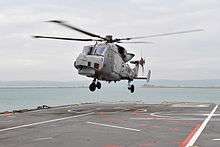
The UK has ordered 34 Wildcats for the British Army and 28 for the Royal Navy.[2] The Army Air Corps formed the Wildcat Fielding Team (Army), which later became 652 (Operational Conversion) Squadron, for trials and operational conversion of Joint Helicopter Command aircrew and ground crew to the type. The Royal Navy also commissioned a Wildcat Fielding Squadron, 700W Naval Air Squadron (700W NAS)[36] in 2009. Both units are located at RNAS Yeovilton. In February 2012, a prototype Wildcat (ZZ402) conducted 20 days of trials aboard HMS Iron Duke off the coasts of England and Scotland; the tests involved operating under challenging weather conditions to define ship-helicopter operating limits for when the type enters service in 2015. During the trials, a total of 390 deck landings were completed including 148 night landings, 76 of which being conducted by pilots using night vision goggles.[37]
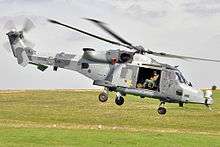
The first production Wildcat was received in May 2012 by the WFT(Army); ZZ406. The Royal Navy received their first airframe at the end of 2013. Further trials of the type were conducted, such as deck landings aboard RFA Mounts Bay.[38] In July 2012, the Wildcat conducted its first public display at the Farnborough Airshow. At the event, Defence Secretary Philip Hammond stated that the "Wildcat represents a considerable advance over the current Lynx helicopters, bringing greatly improved performance and capability."[39]
On 29 August 2014, the Wildcat AH1 formally entered service with the Army Air Corps.[2] On 23 March 2015, the Royal Navy's first Wildcat HMA2 began its initial operational deployment at sea onboard HMS Lancaster.[40] As of September 2015, 48 Wildcats had been delivered to the British Army and Royal Navy; in excess of 10,000 flight hours had been logged between the services along with a 100 percent availability rate achieved at sea and over 1,200 deck landings performed.[41] In September 2015, a Wildcat HMA.2 of 825 Naval Air Squadron was deployed aboard HMS Duncan in the Persian Gulf to perform extreme high temperature trials.[42]
South Korea
On 15 January 2013, South Korea's Defense Acquisition Program Administration announced the selection of the AW159 to fulfill a requirement of the Republic of Korea Navy for a maritime helicopter, winning out against the MH-60R Seahawk. A batch of eight aircraft are to be delivered in 2015–16; these will be used for search-and-rescue missions, anti-submarine warfare and surveillance.[43] In January 2014, DAPA announced it will equip its Wildcat helicopters with Spike NLOS missiles to provide a stand-off attack capability for engaging targets such as ground artillery and small vessels.[44] In April 2015, the South Korean government was considering ordering a further 12 Wildcats to further strengthen the Navy's anti-submarine capabilities; alternative options include the MH-60 Seahawk and the domestically-produced KAI KUH-1 Surion helicopter.[45] On 13 June 2016, the Republic of Korea Navy took delivery of four of the original order of eight Wildcats, after some unspecified initial delays. The helicopters are expected to operate from the navy's Incheon-class guided missile / coastal defense frigates.[46]
Others
In 2014, it was reported that the AW159 was being considered by the Philippine Navy.[47] In March 2016, AugustaWestland secured a €100 million contract with the Philippines' Department of National Defense to supply two helicopters along with training and support. The helicopters are scheduled to be delivered in 2018 with the aim of providing anti-submarine warfare (ASW) and anti-surface capabilities; prior to the introduction of the Wildcat, the Philippines lacked any ASW capabilities in a region where the number of submarines being operated by other nations was reportedly set to grow.[48][49]
In 2016, Malaysia is reportedly considering increasing the number of helicopters operated by the Royal Malaysian Navy by procuring either the AW159, Sikorsky MH-60R Seahawk or the Airbus Helicopters H225M.[50] On 20 April 2016, Finmeccanica (now Leonardo-Finmeccanica) signed a teaming agreement with Global Komited, a Malaysian defence company, to jointly promote and distribute the AW159 Wildcat to the Malaysian government.[51][52]
Variants
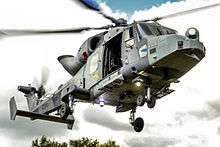
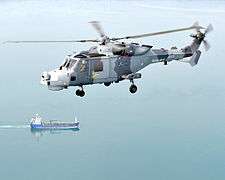
- Wildcat AH1
- Initial battlefield reconnaissance model, total of 30 ordered for the Army Air Corps.[53]
- Wildcat HMA2
- Initial maritime model, total of 28 ordered for the Royal Navy.[54]
Operators
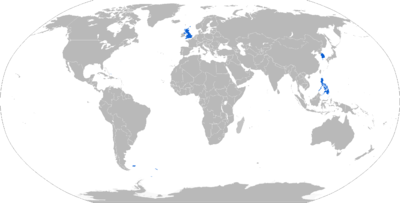
- Philippine Navy (2 ordered)[55]
- Republic of Korea Navy (8 ordered with 4 delivered)[56]
- Army Air Corps[57]
- 652 Squadron (AH1)
- 661 Squadron (AH1)
- Royal Navy[57]
- 815 Naval Air Squadron (HMA2)
- 825 Naval Air Squadron (HMA2)
- 847 Naval Air Squadron (AH1)
Specifications (AW159)
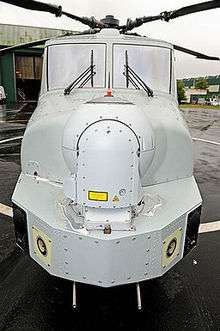
|
|
Data from Future Lynx brochure,[58] AW159 page,[59] militaryfactory.com[60]
General characteristics
- Crew: 2 pilots
- Capacity: 5 passengers, including door gunner
- Length: 15.24 m (50 ft 0 in)
- Height: 3.73 m (12 ft 3 in)
- Empty weight: 3,300 kg (7,275 lb)
- Max takeoff weight: 6,000 kg (13,228 lb)
- Powerplant: 2 × LHTEC CTS800-4N turboshaft, 1,015 kW (1,361 hp) each
- Main rotor diameter: 12.8 m (42 ft 0 in)
- Main rotor area: 128.7 m2 (1,385 sq ft)
Performance
- Maximum speed: 311 km/h (193 mph; 168 kn)
- Range: 777 km (483 mi; 420 nmi)
- Ferry range: 963 km (598 mi; 520 nmi)
- Endurance: 2 hr 15 min (4 hr 30 min with auxiliary fuel tanks)
Armament
- Pintle mounted machine gun, e.g. FN MAG (Army) or Browning M3M (Navy).
Air-to-Surface Missile systems:
- up to 20×[32] Thales Martlet (Lightweight Multirole Missile), formerly Future Anti-Surface Guided Weapon (Light).[61]
- up to 4×[32] MBDA Sea Venom, formerly Future Anti-Surface Guided Weapon (Heavy). Physically similar replacement for the Sea Skua, a combined design with France's Anti-Navire Léger to disable or destroy vessels up to 1000 tonnes.[62]
- Sting Ray torpedo and depth charges[63]
See also
- Related development
- Aircraft of comparable role, configuration and era
- Sikorsky SH-60 Seahawk
- Bell UH-1Y Venom
- Eurocopter Panther
- Kaman SH-2G Super Seasprite
- NH-90
- Harbin Z-15
- Related lists
References
- 1 2 "Lynx Wildcat makes first flight, with AW149 also poised for debut". Flight International. 13 November 2009. Archived from the original on 16 November 2009. Retrieved 2009-11-14.
- 1 2 3 "Army Wildcat continues on track" (PDF). Desider: 15. October 2014.
- ↑ Cobbold, Richard (April 1994). "The Maritime helicopter". Chief of the Defence staff. RUSI Journal. 139 (2): 56–63. doi:10.1080/03071849408445805.
- ↑ Derby, Paul. "GKN Westland offers UK Ministry of Defence upgrade for Lynx." Flight International, 22 February 2000.
- ↑ "Navy may get new version of battle-proven Lynx helicopter". webarchive.nationalarchives.gov.uk. The National Archives. 22 July 2002. Archived from the original on 23 January 2006. Retrieved 20 September 2010.
- 1 2 3 Penney, Stewart. "Westland unveils cockpit concept for Lynx rebuild." Flight International, 15 April 2003.
- ↑ "Thales joins Future Lynx programme." Flight International, 22 July 2002.
- ↑ "AgustaWestland sets its sights on Lynx deals." Flight International, 22 July 2002.
- 1 2 "UK close to forging Future Lynx deal." Flight International, 24 January 2006.
- ↑ "Military pounces as Westland plans upgrade to Super Lynx." Flight International, 19 July 2004.
- 1 2 "UK revamps helicopter strategy." Flight International, 12 October 2004.
- ↑ Hoyle, Craig. "EADS offers to solve UK helicopter crisis." Flight International, 30 November 2004.
- 1 2 "AW159 Lynx Wildcat Battlefield Reconnaissance Helicopter, United Kingdom". army-technology.com. Net Resources International. Archived from the original on 24 September 2010. Retrieved 20 September 2010.
- ↑ Hoyle, Craig. "UK to decide on future helicopters." Flight International, 15 March 2005.
- ↑ "UK commits to Future Lynx helicopter." Flight International, 29 March 2005.
- ↑ Trimble, Stephen. "Rivals stay quiet over UK Future Lynx award – for now." Flight International, 5 April 2005.
- ↑ "AgustaWestland Awarded Future Lynx Contract". AgustaWestland, 22 June 2006.
- ↑ Morrison, Murdo. "Pictures: AgustaWestland to supply 70 Future Lynx helicopters to UK." Flight International, 22 June 2006.
- 1 2 3 4 5 6 7 8 9 Hoyle, Craig. "Pictures: UK's Future Lynx programme moves into manufacturing phase". Flight International, 9 October 2007.
- 1 2 3 4 5 Hoyle, Craig. "AgustaWestland seeks export buyers for AW159 'Lynx Wildcat'." Flight International, 30 April 2009.
- ↑ Hoyle, Craig. "UK cuts Future Lynx deal, delays new carriers". Flight International, 12 December 2008.
- ↑ Hoyle, Craig. "Future Lynx engine gets EASA certification." Flight International, 19 September 2008.
- ↑ O'Keeffe, Niall. "GKN delivers first Future Lynx airframe." Flight International, 17 November 2008.
- ↑ "Future Lynx Is Now The AW159!". AgustaWestland, 24 April 2009.
- ↑ "New Wildcat helicopter unveiled". MOD, 11 July 2012.
- ↑ Second AW159 Lynx Wildcat Makes Its First Flight
- ↑ Hoyle, Craig. "Third Lynx Wildcat joins flight test fleet". Flight International, 23 November 2010.
- ↑ "Wildcat helicopter row turns hostile." defencemanagement.com, 21 July 2009.
- ↑ Chunter, Andrew. "UK Special Forces To Use Wildcat Variant". Defense News, 21 December 2011.
- 1 2 3 4 5 Drwiega, Andrew. "Is the AW159 Lynx Wildcat Wild Enough?." Aviation Today, 1 April 2012.
- ↑ Hoyle, Craig (9 October 2007). "PICTURES: UK's Future Lynx programme moves into manufacturing phase". Flight International. Retrieved 21 September 2010.
- 1 2 3 4 5 Scott, Richard (21 July 2014). "AgustaWestland funded for FASGW integration on Wildcat". IHS Jane's Navy International. Archived from the original on 9 November 2014.
- ↑ UK orders lightweight missiles for naval Wildcat - Flightglobal.com, 17 June 2014
- ↑ "GD to deliver mission system equipment for UK Merlin helicopters." naval-technology.com, 9 December 2014.
- ↑ "BAE Systems' CAGE for UK AW159 Wildcats." Sheppard Media, 17 February 2015.
- ↑ "Fleet Air Arm forms Lynx Wildcat training squadron". shephard.co.uk, May 26, 2009.
- ↑ "Wildcat impresses during its first trials aboard a warship." Navy News, 17 January 2012.
- ↑ "Wildcat crews begin training." Fleet Air Arm Officers Association, 22 July 2013.
- ↑ Gardener, Claire. "Anti-pirate Wildcat helicopter unveiled by Royal Navy." The Scotsman, 29 January 2013.
- ↑ "HMS Lancaster leaves Portsmouth on deployment of 'firsts'". Royal Navy. 23 March 2015. Retrieved 23 March 2015.
- ↑ "AW159 South Korea delivery due this year." Flightglobal.com, 17 September 2015.
- ↑ "Wildcat shows its teeth during Gulf heat trials". Royal Navy. Retrieved 18 September 2015.
- ↑ "South Korea picks AW159 for maritime helicopter deal". Flight International, 15 January 2013.
- ↑ "Seoul to Equip its New Maritime Helicopters with Israeli SPIKE Missiles." Defense-Update.com, 6 January 2014.
- ↑ "South Korea Focuses on Underwater Protection." DefenseNews, 12 April 2015.
- ↑ "South Korea receives first batch of AW159 anti-submarine helicopters" IHS Jane's 360, 14 June 2016.
- ↑ "Philippines to acquire two new ASW helicopters for PHP5.4 billion". IHS Jane's. 18 March 2014. Retrieved 2 January 2015.
- ↑ "Philippines Order British Helos for Anti-Sub Capabilities". Defense News. 31 March 2016.
- ↑ Jennings, Gareth and Mike Cohen. "Philippines selects Lynx Wildcat for ASW mission." IHS Jane's Defence Weekly, 23 March 2016.
- ↑ "AW-159 – Asian Navies Evaluate Acquisition of ASW Helicopters". Defense Update. 23 February 2016. Retrieved 19 April 2016.
- ↑ Jon Grevatt (20 April 2016). "DSA 2016: Finmeccanica and Weststar to offer AW159 to Malaysian navy". IHS Jane’s 360. Retrieved 20 April 2016.
- ↑ Supriya Surendran (20 April 2016). "Weststar Defence unit teams up with Finmeccanica to sell naval helicopters to M'sian govt". The Edge Markets. Retrieved 20 April 2016.
- ↑ Patrick, Allen. "IHS Jane's speaks to the Army Air Corps on the introduction into service of the new Wildcat AH.1 helicopter." IHS Janes, 15 January 2015.
- ↑ Jennings, Gareth. "Royal Navy graduates first operational Wildcat crews." IHS Janes, 2 March 2015.
- ↑ "AgustaWestland sole bidder for 2 Navy anti-submarine helicopters". update.ph. Retrieved 18 February 2016.
- ↑ "South Korea receives first batch of AW159 anti-submarine helicopters". IHS Jane's 360. 14 June 2016. Retrieved 19 July 2016.
- 1 2 "World Air Forces 2013" (PDF). Flightglobal Insight. 2013. Retrieved 7 March 2013.
- ↑ AW Future Lynx. AgustaWestland, May 2009. Retrieved: 8 September 2011.
- ↑ AW159 page (see Technical Data tab). AgustaWestland. Retrieved: 20 January 2014.
- ↑ "AgustaWestland AW159 Wildcat - Development and Operational History, Performance Specifications and Picture Gallery". militaryfactory.com. Retrieved 2016-04-07.
- ↑ Hoyle, Craig. "UK orders Thales lightweight multi-role missiles for Lynx Wildcat". Flightglobal, 4 April 2011.
- ↑ Hoyle, Craig. "Future Air-to-Surface Guided Weapon (FASGW). defense-update.com, 20 February 2012. Archived 12 December 2011 at the Wayback Machine.
- ↑ "Navy News - Reporting from the Fleet". navynews.co.uk. Retrieved 9 August 2016.
External links
| Wikimedia Commons has media related to AgustaWestland AW159 Wildcat. |
- AW159 page on Leonardocompany.com
- "UK commits to Future Lynx helicopter". Flight International, 29 March 2005.
- "UK cuts Future Lynx deal, delays new carriers". Flight International, 12 Dec. 2008.